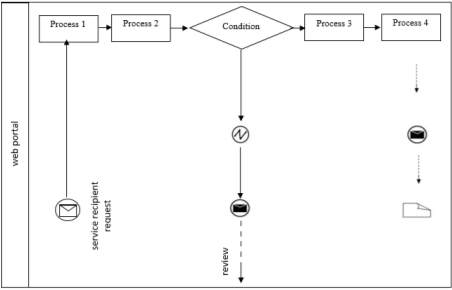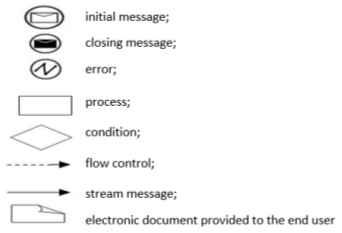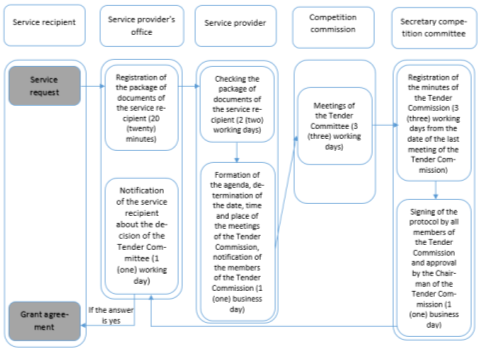In the modern world, the topic of business and startups is relevant. There are many modern business incubators that need to provide an effective information system for the implementation of their projects. An effective information system is needed to allow project participants to access the necessary information and support the project from submitting an application to concluding an agreement with an investor. This article proposes solutions for using the information system in business incubators.
Keywords: information system, business incubation, infrastructure, implementation, reference book.
Today, many young people are struggling to start their own innovation-driven business in order to bring to market something fundamentally new or technology that will increase the competitiveness of a particular product. However, such developments often require access to suitable information, special equipment and materials. Many people do not have the opportunity to realize their idea at the initial stage, when there is only one idea and the desire to bring it to life. In order to create your own technical innovations, it is more logical to contact a business incubator that has a technical and material base.
This article is devoted to the study of organizational and technical management mechanisms and the assessment of experts of innovative projects in business incubators. The inclusion of an infrastructure mechanism in the project management system in the form of an electronic project manager based on convergent technologies is substantiated. It was shown that its use significantly increases the efficiency of expert assessments of projects, including their objectivity and the possibility of automated training of complex projects. [2]
Research focuses on business incubators that can work to develop an innovative small business sector and create conditions for an innovative environment. It should be noted that the problems of incubator management in an innovative economy are currently poorly studied and little covered in scientific publications. [5]
- Overview on Kazakhstani incubators
The incubation process has become one of the infrastructure elements of entrepreneurship support, designed for a long time. Business incubators help in the development and creation of small and medium-sized enterprises, in most cases, of an innovative type [4].
Analyzing the Kazakhstani market, more than 10 incubators operate in the country. There is a map of the startup ecosystem of Kazakhstan, created in June 2018. The purpose of this card is to benefit all market participants — startups, investment companies, business angels, government and the corporate sector. For startups, it is a guide to the development of a business project: to whom and to which organization to contact at different stages of project development; for investors: where to look for start-up companies; states: what participants are on the market, what conditions need to be created to support it; for the corporate sector — to introduce innovations into their activities in partnership with existing market players.
The startup ecosystem map was created by the MOST incubator. In addition to MOST itself, there are nFactorial, TechGarden, Astana Hub, Impact Hub, Sod-Bi, SmArt.Point, Astana Business Campus, KBTU Startup Incubator, KazNU Science and Technology Park and Venture PSU. Most of the incubators are located in Nur-Sultan and Almaty.
These business incubators in Kazakhstan work in three directions:
– independent: nFactorial, Astana Hub, SmArt.Point, MOST, Impact Hub, TechGarden, SodBi.
– student: Astana Business Campus, KBTU Startup Incubator, Science and Technology Park of KazNU named after Al-Farabi, PSU named after S. Toraigyrova «Venture».
– accelerators: ico.Startup Kazakhstan, Technation, Astana Business Campus Quick Start, MOST.
MOST officially launched in September 2015. It became the first private business incubator in Kazakhstan that supports innovators at the stages from the idea of an idea to its implementation. In total, more than 60 companies passed through MOST, 15 of them were able to attract investments from the market.
Astana Hub, the international technopark of IT startups, has been launched in 2018 in Astana on the territory of the EXPO. In February, the first stream of the acceleration program was launched, in which 10 startups participated, and about 50 teams entered the incubator. The purpose of the Technopark is to develop an ecosystem of innovations for IT business in Kazakhstan. To do this, they provide support to entrepreneurs from the idea stage to the formation of a successful business.
In Kazakhstan, the state is also involved in supporting the innovation ecosystem. Under the National Agency for Technological Development (NATD), technoparks used to work in the regions of the country. But now the agency has moved from managing technoparks to a policy of stimulating business incubators. Therefore, within the framework of a single program «Business Roadmap — 2020", a program to support business incubation was developed.
NATD will conclude a three-year contract with each of the incubators. According to the agency, the program will help the Kazakhstani ecosystem of business incubation to become self-sufficient both financially and in terms of competence. And this, in turn, will stimulate the development of startups in the country. To assist in the development of incubation and developed a program. And to stimulate investment in startups, amendments to the legislation on venture financing were adopted.
The innovative activity of companies in Kazakhstan is growing. According to the Committee on Statistics of the Ministry of National Economy, in 2003 this indicator for technological innovations was 2.1 %, and by 2017 it more than doubled — to 5.7 %. And if we take into account all types of innovations, then the numbers are higher — 9.6 %.
The market is also changing noticeably. Previously, there was almost no talk about startups, but now in Kazakhstan, several thematic conferences are held every year.
- The architecture of the information system for supporting projects of innovative business incubators
An information system for supporting projects of innovative business incubators based on organizing the selection of projects for investors using an electronic dispatcher who interacts with the expert commission, the project database and all information on the project that is required by potential investors [1].
This diagram shows the queue for the provision of public services:

Fig. 1. Diagram of the functional interaction of information systems involved in the provision of public services

Fig. 2. Symbols
Providing state grants to small businesses for the implementation of new business ideas within the framework of the State program for support and development of business «Business Roadmap 2020".

Fig. 3. Directory of business processes for the provision of public services

Fig. 4. Symbols of data in the reference book
Public service delivery form: paper / electronic.
Description of the order of actions of the structural divisions (employees) of the service provider in the process of rendering public services:
The content of the procedures that are part of the process of providing public services, the duration of the execution:
– action 1 — the office of the service provider accepts and registers the package of documents of the service recipient. Duration of execution — 20 minutes;
– action 2 — the service provider's executor checks the completeness of the package of documents, checks the service recipient's project for compliance with the conditions for the provision of public services, considers information about participation in other state programs, the use of other state support measures through state development institutions, considers projects of service recipients implemented in the prio — sectors of the economy of high priority for the region, submits to the RCC a list of projects of service recipients, forms an issue on the agenda, determines the date, time and place of the RCC meeting. Duration of execution — 5 working days;
– action 3 — holding a meeting of the RCC. Duration of execution — 1 working day;
– action 4 — the RCC secretary draws up the minutes of the RCC meeting, preparation of an extract from the minutes of the RCC meeting and a cover letter. Duration of execution — 2 working days;
– action 5 — the service provider's office is registering a cover letter and an extract from the minutes of the RCC meeting. Duration of execution — 1 working day.
The term for the provision of public services from the date of delivery of the package of documents to the service provider is 11 working days.
The result of the procedure for the provision of public services in accordance with action 1, referred to in paragraph 5 of this Regulation, are registered documents of the service recipient, which serve as the basis for initiating the implementation by action 2 specified in paragraph 5 of this Regulation.
The result of the procedure for the provision of public services under action 2, specified in clause 5 of these Regulations, is the coordination of the date, time, place of the meeting of the RCC, which serves as the basis for starting the implementation of action 3 specified in clause 5 of these Regulations.
The result of the procedure for the provision of public services according to action 3, specified in paragraph 5 of these Regulations, is a meeting of the RCC, which serves as the basis for starting the implementation of action 4 specified in paragraph 5 of these Regulations.
The result of the procedure for the provision of public services according to action 4, specified in paragraph 5 of this Regulation, is a completed RCC protocol, indicating the reasons for the provision / non-provision of guarantees, which serves as the basis for starting action 5 specified in paragraph 5 of these Regulations.
The result of the procedure for the provision of public services according to action 5, specified in paragraph 5 of these Regulations, is an extract from the RCC minutes. [7]
The procedure for applying and the sequence of procedures of the service provider and the service recipient in the provision of public services through the web portal:
1) the service recipient performs registration on the web portal using his registration certificate with an EDS, which is stored in the Internet browser of the service recipient's computer (carried out for unregistered service recipients on the web portal);
2) process 1 — attaching an EDS registration certificate to the Internet browser of the recipient's computer, the process of entering the password by the recipient (authorization process) on the web portal for obtaining public services;
3) condition 1 — verification on the web portal of the authenticity of the data about the registered service recipient through the login (IIN / BIN) and password;
4) process 2 — the formation by the web portal of a message about the refusal of authorization in connection with the existing violations in the data of the service recipient;
5) process 3 — selection by the service recipient of the service specified in this regulation, displaying the request form for the provision of the service and filling in the form by the recipient (data entry), taking into account its structure and format requirements, attaching the necessary documents to the request form in electronic form;
6) process 4 — payment for services at PSHEP, and then this information enters the IS of the GBD;
7) condition 2 — checking in the IS GDS of the fact of payment for the provision of the service;
8) process 5 — the formation of a message about the refusal of the requested service, due to the lack of payment for the provision of the service in the IS GBD;
9) process 6 — selection by the service recipient of the registration certificate with an EDS for certification (signing) of the request;
10) condition 3 — verification on the web portal of the validity period of the registration certificate of the EDS and the absence in the list of revoked (canceled) registration certificates, as well as the correspondence of identification data between the IIN / BIN specified in the request and the IIN / BIN specified in the registration certificate of the digital signature;
11) process 7 — generation of a message about the refusal of the requested service due to non-confirmation of the authenticity of the EDS of the service recipient;
12) process 8 — certification (signing) by means of the EDS of the service recipient of the completed form (entered data) of the request for the provision of the service;
13) process 9 — registration of an electronic document (service recipient's request) in the IS GBD and processing the request in the IS GBD;
14) condition 4 — verification by the service provider of the compliance of the service recipient with the qualification requirements and the grounds for the provision of public services;
15) process 10 — generation of a message about the refusal of the requested service due to existing violations in the data of the service recipient in the IS SBS;
16) process 11 — the receipt by the service recipient of the result of the provision of public services generated by the web portal. An electronic document is generated using the EDS of an authorized person of the service provider.
Note. Explanation of abbreviations:
IS GBD — information system of the state database;
IIN — individual identification number;
BIN — business identification number;
PSHEP — «electronic government» payment gateway;
EDS is an electronic digital signature. [8]
Conclusion
For people who want, but are unable to start their own business on their own due to financial difficulties or lack of knowledge, a business incubator is a unique opportunity to realize their entrepreneurial talent. When the project is approved as an object of support, the company is provided with a quick start, accelerated development and minimization of risks. [6]
For those who want to start their own business, but cannot open due to financial difficulties or lack of knowledge, a business incubator is a unique opportunity to develop their entrepreneurial skills. If the project is approved as a form of support, the company will launch quickly, grow quickly and reduce risks. [3]
In this article:
– a study was carried out on the experience of business incubation in Kazakhstan in order to clarify and define the mechanisms for managing existing infrastructure projects;
– the organizational and technical model of managing an innovative business incubator based on a technological platform using convergent technologies was combined;
– for the implementation of the management system and expert evaluation of projects by incubators, a version of the basic configuration model was proposed in the network, in online mode. The economic efficiency of its implementation was based on investment projects in order to constantly monitor the status of potential baseline information.
In conclusion, I would like to note that the development and implementation of this system will reduce the percentage of choice for financial support of low-quality and increase the number of potentially attractive investment projects, which means it will allow the country to reach a new level. An increase in the quality of service delivery and this will be available to an online entrepreneur is also given access by an online entrepreneur.
References:
- Multi-agent information system for supporting projects of innovative business incubators / S. G. Fomicheva, T. N. Elina, S. S. Panchenko, I. S. Belyaev // Modern trends in science and education: Sat. scientific tr according to the materials of the Intern.scientific-practical conf. March 3, 2014 at 6 p. Part II. — M.:AR-Consult, 2014.-- S. 126.
- Chertina, E. V. Comprehensive quantitative assessment of innovative IT projects based on fuzzy — multiple descriptions / E. V. Chertina, I.Yu. Kvyatkovskaya // Caspian Journal: Management and High Technologies. — 2016.– No. 1 (33). — S. 50–62.
- Chertina, E. V. Information System for Evaluation, Analysis, Selection and Monitoring of Innovative IT Projects / E. V. Chertina, I.Yu. Kvyatkovskaya // Fundamental research. — 2016. — No. 5. Part 3 — S. 526–530.
- Landau Yu.V., Chernitsova K. A. The concept of the maturity of business processes // Innovations and Investments. 2013. No.7. S. 110–113.
- Chernitsova K. A. Economic advantages of developing customer focus on business // Bulletin of the Russian University of Economics G. V. Plekhanov. 2014. No. 7 (73). S.64–71.
- Levin Yu.A., Pavlov A. O., Konotopov V. M. Evaluation of an entrepreneurial motive for profit as one of the factors in the spread of innovation // Innovations and Investments. 2014. No.10. P. 21–22.
- http://adilet.zan.kz/rus/docs/V1500011181
- https://legalacts.egov.kz/npa/view?id=1781326







